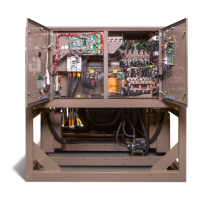JOHNSON CONTROLS
12
SECTION 1 - GENERAL CHILLER INFORMATION AND SAFETY
Form 201.47-ICOM1
Issue date: 17/11/2022
Quality assurance and safety
YVAA chillers are designed within EN ISO 9001 and
built within an EN ISO 9002 accredited manufacturing
organization.
Units conform with the following European Directives:
• Machinery Directive (2006/42/EC)
• EMC Directive (2004/108/EC)
• Pressure Equipment Directive (2014/68/EU)
• Low Voltage Directive (2006/95/EC)
• Safety Code for Mechanical Refrigeration
(EN378-2(2016))
CE/PED marked units conform to the following
standards:
• Machinery Directive (2006/42/EC).
• EMC Directive (2004/108/EC).
• Pressure Equipment Directive (2014/68/EU).
• Low Voltage Directive (2006/95/EC).
• Safety Code for Mechanical Refrigeration
(EN378-2(2016)).
ETL/ASME marked units conform to the following
standards:
• ANSI/ASHRAE 15 – Safety Code for
Mechanical Refrigeration.
• ANSI/ASHRAE 34 – Number Designation and
• ANSI/NFPA 70 – National Electrical Code
(NEC).
• ASME Boiler and Pressure Vessel Code, Section
VIII, Division 1.
GB marked units conform to the following standards:
• GB5226.1 Safety of machinery - Electrical equip-
ment of machines – Part 1: General requirements.
• GB25131 Safety requirements for water chiller
(heat pump) using the vapor compression cycle.
• GB18430.1 Water chilling (heat pump) package
using the vapor compression cycle Part 1: Water
chilling (heat pump) package for industrial and
commercial and similar applications.
• NB/T 47012 Pressure vessels for refrigerant
equipment.
Fluorinated greenhouse gases
•
gases covered by the Kyoto Protocol.
• The global warming potential of the refrigerant
R134a is 1300. The global warming potential for
R513A is 546. Both use the integrated time of 100
years based on IPCC 5th report 2013, Table 8.A.1.
• The refrigerant quantity is as stated in
Table 5 on page 66 of this document.
• -
ment may not be vented to the atmosphere.
• This equipment must only be serviced by
Responsibility for safety
Every care has been taken in the design and manufac-
ture of the unit to ensure compliance with the safety
requirements listed above. However, the individual
rigging, lifting, maintaining, operating, or working on
any machinery is primarily responsible for:
• Personal safety, safety of other personnel, and the
machinery.
• Correct utilization of the machinery in accordance
with the procedures detailed in the manual.
About this manual
The contents of this manual include suggested best
working practices and procedures. These are issued for
guidance only, and they do not take precedence over
the above stated individual responsibility or local safe-
ty regulations.
This manual and any other document supplied with
the unit are the property of Johnson Controls which re-
serves all rights. They may not be reproduced, in whole
or in part, without written authorization from an autho-
rized Johnson Controls representative.
Misuse of equipment
Suitability for Application
The unit is intended for cooling water or glycol solu-
tions and is not suitable for purposes other than those
specified in these instructions. Any use of the equip-
ment other than its intended use, or operation of the
equipment contrary to the relevant procedures may re-
sult in injury to the operator, or damage to the equip-
ment.
The unit must not be operated outside the design pa-
rameters specified in this manual.

